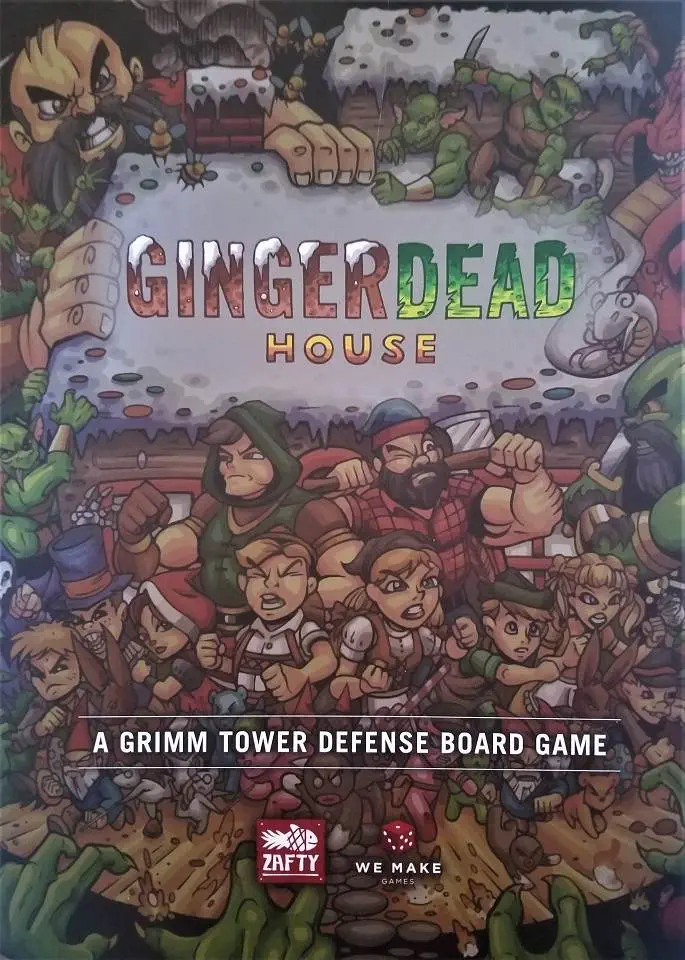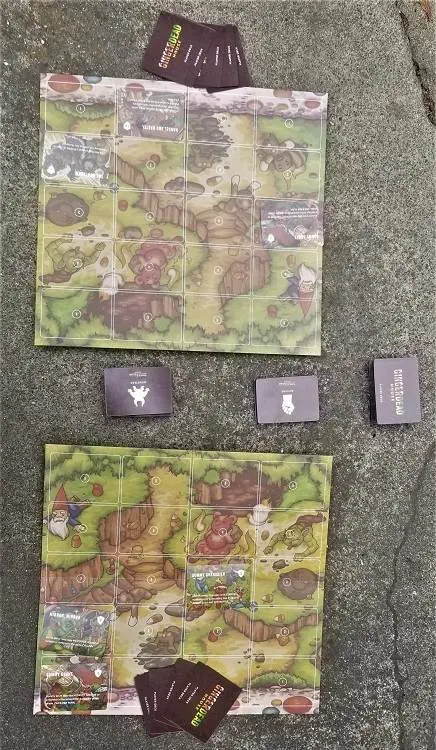
Typically flavored with cloves, ginger, nutmeg, or cinnamon and sweetened with honey, sugar, or molasses, gingerbread is not often considered for building materials in the real world. In Gingerdead House, however, players enter the realm of Grimm’s Fairy Tales and find themselves in quite a predicament. After having purchased a tasty piece of property, the new homeowners must now defend their dwellings from those who wish to devour the sweet-tasting domicile. With the aid of fantastical defenses and several tricks up their sleeves, which player will be the last one standing with their home intact?
Gingerdead House first appeared on Kickstarter with an early 2016 crowdfunding campaign. This fairy tale inspired tower defense board game was designed by Bryce Walter and Jonathan Rivera of We Make Games and features illustrations from James “Bukshot” Bukauskas. Bukauskas is also known for his work as a comic book illustrator, mural artist, and tattoo artist among other professions. With these experiences, he brings a lot of unique style to the art of the game. Gingerdead House was published by Zafty Games, who is known primarily for the Pixel Glory franchise as well as their more recent releases of ToeShamBo and Somnium: Rise of Laputa. After much controversy, however, Zafty Games and those involved with the company have seemingly disappeared. It is assumed by many that Zafty itself is now defunct. We Make Games, also, seems to have disappeared prior to their expected Kickstarter for a new post-apocalyptic game (Sojourn) ever launched.

There are three different decks used in Gingerdead House: the Action Deck, Monster Deck, and Player Deck. The Player Deck is made up of both Trick and Defense cards. Each of these decks should be shuffled separately and placed within reach of all players with room for discard piles. Each player receives their own board and places it in front of them. They also get three starting defense cards. Typically, we deal cards individually to each player until everyone has three Defense cards in front of them. However, players can choose their own method as long as each player ends up with three starting Defense cards. Any card that is not a Defense card is shuffled back into the Player deck. Each player then places their Defense cards on their own board in the locations of their choice. All players are dealt a new hand of five cards and the game is ready to begin.
Gingerdead House is played over a series of rounds made up of individual turns. At the beginning of a player’s turn, they must first flip the top card of the Action Deck. These cards tell the player how many monsters are entering the field this turn as well as any applicable card effects. Next, the monsters are deployed. All monsters will enter the field in row 5. Each Monster card has an indicator at the bottom pertaining to which lane they are deployed to. If a monster is entering the field in the same spot as a previously placed one, it pushes them forward into the next row towards the player’s house. Some monsters have card effects that trigger upon entering the field, when moving, or when being destroyed. Once all monsters have entered the field for that turn, the player can then use as many cards from their hand as they would like. This can be any combination of Tricks or Defenses and can help or hinder your opponents as well as yourself. Once all cards are played, the Monsters move and attack. Monsters move down one row, starting from the left and moving lane by lane. If a monster comes in contact with a Defense card, combat occurs immediately. Whichever card has a higher value wins the combat. If they are tied, both cards are destroyed. It’s important to note that damage is not cumulative. Should a monster get past row 1, the player is eliminated and the games when only one player remains.

There are currently two mini-expansions available for Gingerdead House. The Walking Bread was released in late 2016 and featured ten new cards. These cards center on zombie themes and the resurrection keyword from the game. The new cards include several new cards of each of the four card types. In addition to being a parody/spoof of The Walking Dead, there are several easily recognizable zombified Grimm characters included as well. All of the art for The Walking Bread expansion was provided by Ben Lopez. The second expansion, Star Smores, came out in 2017 and featured artwork from yet another new artist, Davy Wagnarok. Star Smores adds fourteen new cards to the game, but unlike the previous expansion does not focus on any specific keywords. Instead, Star Smores expands upon the universe contained within Gingerdead House to include outer space and a Star Wars parody. Both of these expansions were added to the game via independent pay-what-you-want style Kickstarter campaigns.
While Gingerdead House is certainly not the first tower defense board game I have ever played, it certainly ranks high on my list! This is a game that is easy to learn, easy to play and has a lot of replayability. It is also a game that can take very unforeseen twists and a player can go from thinking they are ahead to being in dire straights within seconds – and not even on their own turn! The game has a lot of “take that” mechanics, so if that is not your play style, that is something to consider when looking at picking this up. Gingerdead House also offers two alternate modes of play including a 2v2 co-op mode, which is my favorite! I’ve had this game since the original Kickstarter back in 2016 and it still hits the table today. The circumstances involving both the publishing company and design company make Gingerdead House a more difficult to find game these days, but I have yet to find anyone who has played this that does not love it. If you know someone who has a copy already, or can find one to pick up yourself, this is a great choice to bring to the table this holiday season.
All photos of Zafty Games product were taken and edited by Krista.